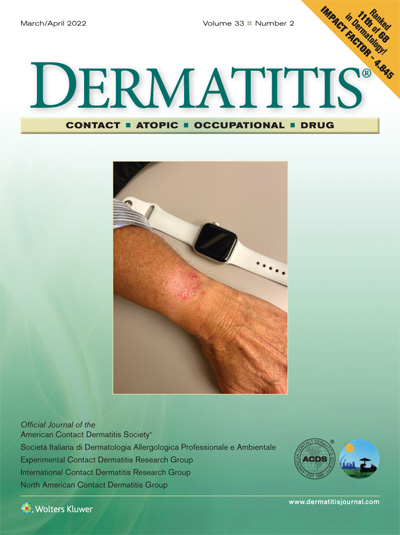穿越皮肤的旅行:回顾迷幻药和致幻剂的皮肤药物反应。
IF 3.2
3区 医学
Q1 DERMATOLOGY
引用次数: 0
摘要
尽管迷幻药和致幻药物在治疗方面越来越受欢迎,但它们对皮肤的不良影响却鲜为人知。本综述描述了与迷幻药和致幻剂相关的皮肤反应。从数据库建立之初到 2023 年 8 月 31 日,我们对 PubMed 和 Scopus 进行了检索。搜索关键词包括药物名称和类别(大麻、亚甲二氧基甲基苯丙胺、摇头丸、3,4-亚甲二氧基甲基苯丙胺、迷幻剂、致幻剂、仙人掌、大麻、麦角酰二乙胺、迷幻剂、氯胺酮、二甲基色胺、DMT)、二甲基色胺、DMT、苯环利定、PCP、右美沙芬、西洛西宾和死藤水),以及皮肤病术语(皮炎、接触性皮炎、药物疹、皮肤反应和荨麻疹)。如果研究涉及迷幻药或致幻药以及任何皮肤反应,则将其纳入研究范围;不涉及这两种成分的研究将被排除在外。有 22 项研究符合纳入标准,描述了对大麻(10 项研究)、摇头丸(5 项研究)、氯胺酮(4 项研究)和迷幻药(3 项研究)的反应。共纳入了 40 名患者。在与大麻有关的反应中,最常见的反应是局部接触导致的 I 型超敏反应(n = 21)。三名患者报告了因接触大麻或大麻衍生精油而引起的 IV 型超敏反应,他们都出现了水泡型接触性皮炎。另有两名患者在全身用药后分别出现红斑-多形性反应和急性全身性泛发性脓疱病。亚甲二氧基甲基苯丙胺与痤疮样疹子(2 例)、荨麻疹疹子、肠型牛皮癣样反应、固定药物疹子和史蒂文斯-约翰逊综合征(1 例)有关。四名患者报告了对氯胺酮的 I 型超敏反应。4 名患者报告对迷幻药出现水泡状糜烂、发绀或大面积黄疸。在这些病例中,8 例患者的皮肤反应在停药后缓解,10 例在停药加治疗后缓解,7 例未报告缓解情况。没有发现关于其他迷幻药或致幻化合物的研究。还需要进一步研究,以确定与各种现存迷幻药和致幻剂有关的反应和治疗方法。本文章由计算机程序翻译,如有差异,请以英文原文为准。
Trips Through the Skin: Reviewing Cutaneous Drug Reactions to Psychedelics and Hallucinogens.
Although psychedelic and hallucinogenic substances have gained popularity for therapeutic use, their dermatologic adverse effects are poorly characterized. This review characterizes the cutaneous reactions associated with psychedelic and hallucinogenic drugs. A review of PubMed and Scopus was conducted from the inception of databases to August 31, 2023. Search terms included drug names and classes (cannabis, MDMA, ecstasy, 3,4-methylenedioxymethamphetamine, psychedelics, hallucinogens, peyote, marijuana, lysergic acid diethylamide, LSD, ketamine, dimethyltryptamine, DMT, phencyclidine, PCP, dextromethorphan, psilocybin, and ayahuasca), and dermatosis terms (dermatitis, contact dermatitis, drug eruption, skin reaction, and urticaria). Studies were included if there was an association with a psychedelic or hallucinogenic and any cutaneous reaction; studies without both components were excluded. Twenty-two studies met inclusion criteria, describing reactions to cannabis (10 studies), MDMA (5 studies), ketamine (4 studies), and psilocybin (3 studies). Forty total patients were included. Among cannabis-related reactions, the most common reaction was type I hypersensitivity by topical exposure (n = 21). Three patients reported type IV hypersensitivity reactions to contact with cannabis or cannabis-derived oils, all of whom experienced vesicular contact dermatitis. Two additional patients presented with an erythema-multiforme-like reaction and acute generalized exanthematous pustulosis after systemic administration, respectively. MDMA was associated with acneiform eruptions (2 cases), an urticarial eruption, a guttate psoriasis-like reaction, a fixed drug eruption, and Stevens-Johnson syndrome (1 case). Four patients reported type I hypersensitivity reactions to ketamine. Four patients reported vesicular eruptions, cyanosis, or widespread jaundice to psilocybin. Of the cases, 8 patients had cutaneous reactions that resolved with drug cessation, 10 resolved with cessation plus treatment, and resolution in 7 cases was not reported. Zero studies were found describing other psychedelic or hallucinogenic compounds. Further research is required to characterize reactions and treatments linked to the variety of extant psychedelics and hallucinogens.
求助全文
通过发布文献求助,成功后即可免费获取论文全文。
去求助
来源期刊

Dermatitis
医学-皮肤病学
CiteScore
5.30
自引率
11.50%
发文量
251
审稿时长
>12 weeks
期刊介绍:
Dermatitis is owned by the American Contact Dermatitis Society and is the home journal of 4 other organizations, namely Societa Italiana di Dermatologica Allergologica Professionale e Ambientale, Experimental Contact Dermatitis Research Group, International Contact Dermatitis Research Group, and North American Contact Dermatitis Group.
Dermatitis focuses on contact, atopic, occupational, and drug dermatitis, and welcomes manuscript submissions in these fields, with emphasis on reviews, studies, reports, and letters. Annual sections include Contact Allergen of the Year and Contact Allergen Alternatives, for which papers are chosen or invited by the respective section editor. Other sections unique to the journal are Pearls & Zebras, Product Allergen Watch, and news, features, or meeting abstracts from participating organizations.
 求助内容:
求助内容: 应助结果提醒方式:
应助结果提醒方式:


